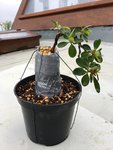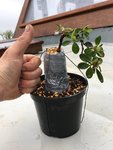Woocash
Omono
I bought this Azalea Japonica ‘orange’ from a supermarket a couple of months ago and have been waiting for the flowers to come and go and for some soil and kanuma to arrive so I could have a go at a small neagari project. I got a drinks bottle, cut out a section and gaffered it up to form a root tube. I then filled a pot with kaizen number 1 soil and perched the tube on top. Next I washed of the roots of the plant, chopped off any upward facing roots and, holding it at the top of the tube, filled the cavity with kanuma. I then wired the tube to the under pot for stability and pruned and wired the azalea itself.
I thought that with the exposed root style often being quite delicate looking, a cascade or semi cascade style would suit nicely but I can’t find any real examples of a cascading neagari azalea. Am I not looking hard enough or is it not often done?
I forgot to take any pictures of the process but I have another similar azalea called ‘red’ which I will do the same with when it goes over so I’ll take a few more pics then. Heres my first attempt anyway. Any thoughts, tips for aftercare or whatnot would be gratefully received.
 (It’s pretty diddy)
(It’s pretty diddy)
 in flower before the operation
in flower before the operation
I thought that with the exposed root style often being quite delicate looking, a cascade or semi cascade style would suit nicely but I can’t find any real examples of a cascading neagari azalea. Am I not looking hard enough or is it not often done?
I forgot to take any pictures of the process but I have another similar azalea called ‘red’ which I will do the same with when it goes over so I’ll take a few more pics then. Heres my first attempt anyway. Any thoughts, tips for aftercare or whatnot would be gratefully received.

 (It’s pretty diddy)
(It’s pretty diddy) in flower before the operation
in flower before the operation

